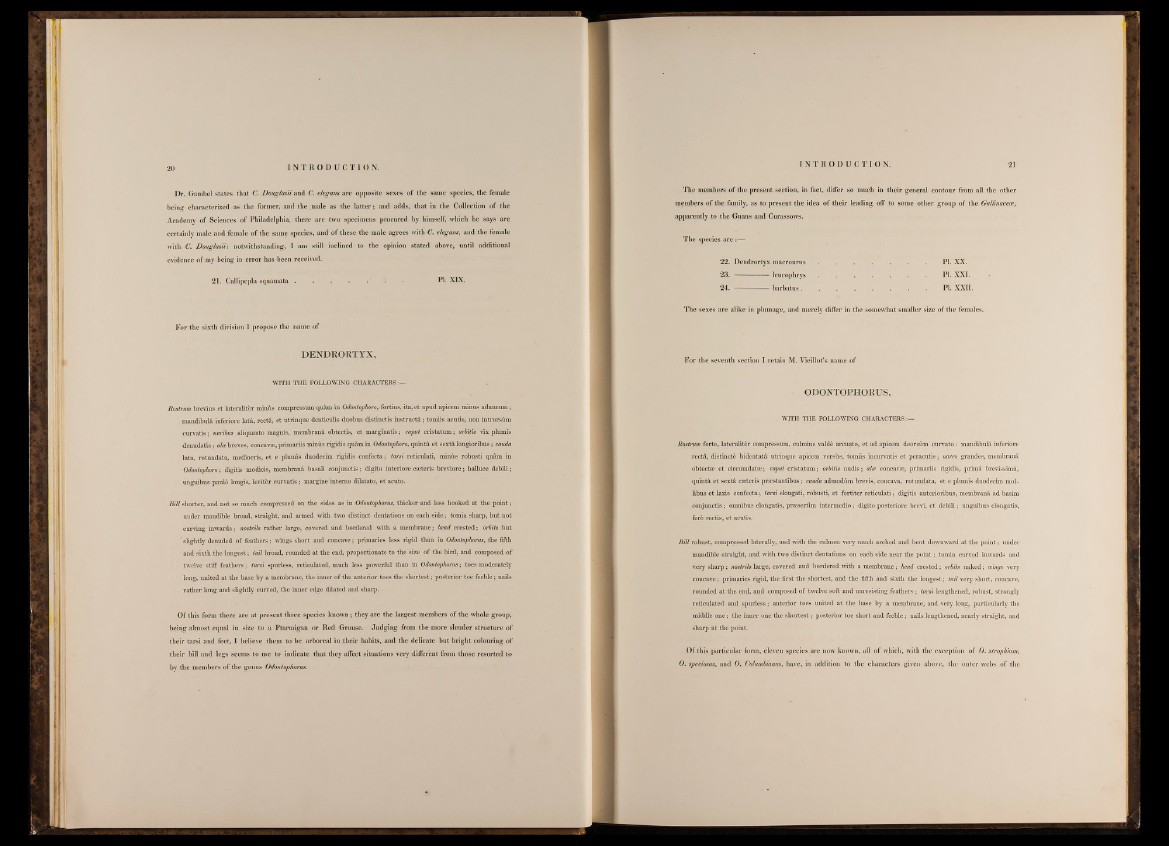
Dr. Gambel states that C. Douglasii and C. elegans are opposite sexes of the same species, the female
being characterized as the former, and the .male as the latter; and adds, that in the Collection of the
Academy of Sciences of Philadelphia, there are two specimens procured by himself, which he says are
certainly male and female of the samp species, and of these the male agrees with C. elegans, and the female
with C. Douglasii: notwithstanding, I am still inclined to the opinion stated above, until additional
evidence of my being in error has been received.
21. Callipepla squamata............................................... PI. XIX.
For the sixth division I propose the name of
DENDRORTYX,
WITH THE FOLLOWING CHARACTERS
Rostrum, brevius et lateralitbr minAs compressum qu&m in Odontophoro, fortius, ita, et apud apicem minus aduncum;
inandibulii inferiore lat&, recti, et utrinque denticulis duobus distinctis in stru c ts; tomiis acutis, non introrsAm
curvatis; naribus aliquanto magnis, membrani obtectis, et marginatis; caput cristatum; orbitis vix plumis
denudatis; alee breves, concavse, primariis minAs rigidis quim in Odontophoro, quinti et sexti longioribus; cauda
lata, rotundata, mediocris, et e plumis duodecim rigidis confecta; tarsi reticulati, minAs robusti quim in
Odontophoro; digitis modicis, membrani basali conjunctis; digito interiore caeteris breviore; halluce debili;
unguibus paulA longis, levit&r curvatis ; margine intemo dilatato, et acuto.
Bill shorter, and not so much compressed on the sides as in Odontophorus, thicker and less hooked a t the point;
under mandible broad, straight, and armed with two distinct dentations on each side; tomia sharp, but not
curving inwards; nostrils rather large, covered and bordered with a membrane; head crested; orbits but
slightly denuded of feathers; wings short and concave; primaries less rigid than in Odontophorus, the fifth
and sixth the longest; tail broad, rounded a t the end, proportionate to the size of the bird, and composed of
twelve stiff feathers; tarsi spurless, reticulated, much less powerful than in Odontophorus; toes moderately
long, united at the base by a membrane, the inner of the anterior toes the shortest; posterior toe feeble; nails
rather long and slightly curved, the inner edge dilated and sharp.
Of this form there are at present three species known; they are the largest members of the whole group,
being almost equal in size to a Ptarmigan or Red Grouse. Judging from the more slender structure of
their tarsi and feet, I believe them to be arboreal in .their habits, and the delicate but bright colouring of
their bill and legs seems to me to indicate that they affect situations very different from those resorted to
by the members of the genus Odontophorus.
The members of the present section, in fact, differ so much in their general contour from all the other
members of the family, as ¡to present the idea of their leading off to some other group of the GaUinaceee,
apparently to the Guans and Curassows.
The species are :—
22. Dendrortyx macrounis . . . . . . . . PI. XX.
23. -------------- leucophrys . . . . . . . PI. XXI.
24. —;— — barbatus. . . . . . . . PI. XXII.
The sexes are alike in plumage, and merely differ in the somewhat smaller size of the females.
For the seventh section I retain M. Vieillotfs name of
ODONTOPHORUS,
WITH THE FOLLOWING CHARACTERS
Rostrum forte, lateralit&r compressum, culmine vald& arcuato, et ad apicem deorsum curvato : inandibulii inferiore
rectd, distinct^ bidentatd utrinque apicem versAs, tomiis incurvatis et peracutis; nares grandes, membranA
obtectse et circumdatee; caput cristatum; orbitis nudis; alee concavse, primariis rigidis, primd brevissimd,
quintal et sextA cseteris prsestantibus; cauda admodAm brevis, concava, rotundata, et e plumis duodecim mol-
libus et laxis confecta; tarsi elongati, robusti, et fortiter reticulati; digitis anterioribus, membrand ad basim
conjunctis; omnibus elongatis, prsesertlm intermedio ; digito posteriore brevi, et debili; unguibus elongatis,
ferfe rectis, et acutis.
Bill robust, compressed laterally, and with the culmen very much arched and bent downwai'd at the point; under
mandible straight, and with two distinct dentations on each side near the poin t; tomia curyed inwards and
very sh arp ; nostrils large, covered and bordered with a membrane; head crested; orbits naked; wings very
concave; primaries rigid, the first the shortest, and the fifth and sixth the longest; tail very short, concave,
rounded a t the end, and composed of twelve soft and unresisting feathers ; tarsi lengthened, robust, strongly
reticulated and spurless; anterior toes united a t the base by a membrane, and very long, particularly the
middle one; the inner one the shortest; posterior toe short and feeble; nails lengthened, nearly straight, and
sharp at the point.
Of thi.s particular form, eleven species are now known, all of which, with the exception of 0 . strophium,
0 . speciosus, and 0 . Columbianus, have, in addition to the characters given above, the outer webs of the